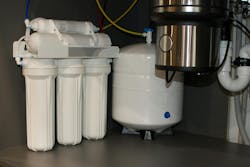Study: POU/POE treatment viable for SDWA compliance
A research study funded by the Water Quality Research Foundation finds that point-of-use or point-of-entry (POU/POE) water treatment could be viable in complying with Safe Drinking Water Act (SDWA) requirements.
The University of Massachusetts Amherst study demonstrates how community water systems can examine three different factors together to determine whether it’s better to upgrade their centralized treatment plant or provide point-of-use or point-of-entry treatments to customers.
The findings were published in AWWA Water Science, a peer-reviewed interdisciplinary journal of research on the science, engineering and social aspects of water.
The researchers examined environmental, economic and public health impacts that these smaller water systems could review in determining how best to comply with SDWA requirements. These small drinking water systems often suffer from repeated SDWA violations that necessitate upgrades to the existing centralized systems to achieve compliance.
Although POU/POE devices are usually quicker and easier to install than making centralized upgrades, increased regulatory burdens can significantly increase the cost and delay the timeline when these solutions are used for SDWA compliance. Even so, the study mathematically shows that over a 30-year period, POU/POE options can be cheaper, more environmentally sensitive and quicker — providing greater health risk reductions to the community - than upgrading existing infrastructure. Newly built systems were not included in the study.
For example, the study featured the case of 50 New Hampshire residents whose water contained 1.6 times the legal limit of arsenic. The research determined that reverse osmosis systems could save the water system $3,312 per resident, activated carbon filter could save $4,063 per resident, and in-home treatment could be implemented a full year sooner than treatment plant upgrades, saving residents from more arsenic exposure. The analysis determined that RO treatment was the most environmentally sustainable option, while central plant improvements were the least.
An executive summary of the sustainability study is publicly available on the WQRF website, and Water Quality Association members have access to the full study.
